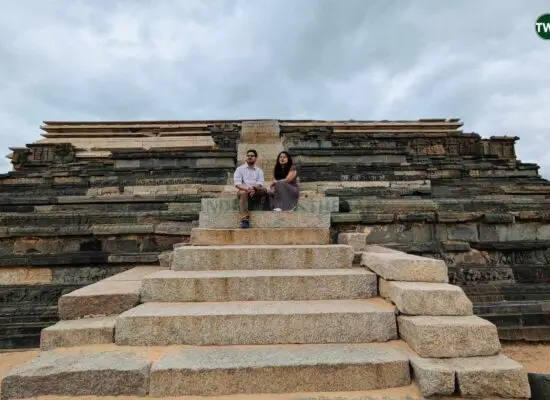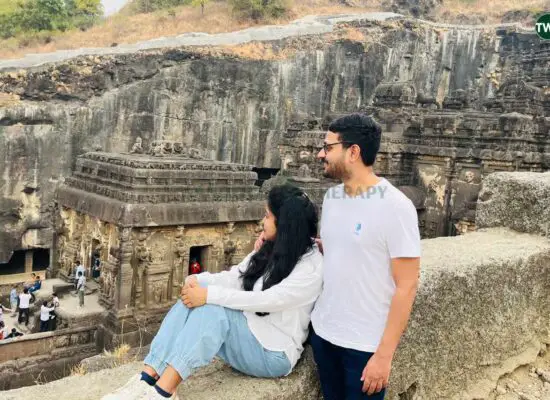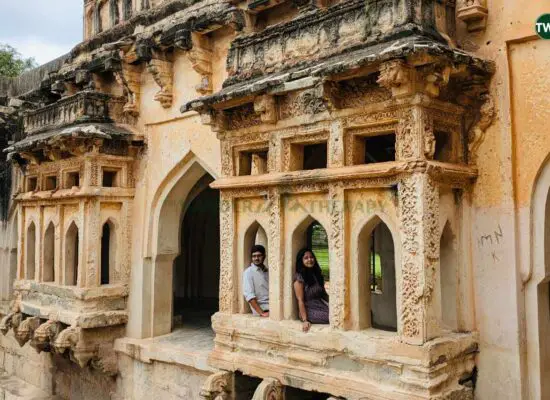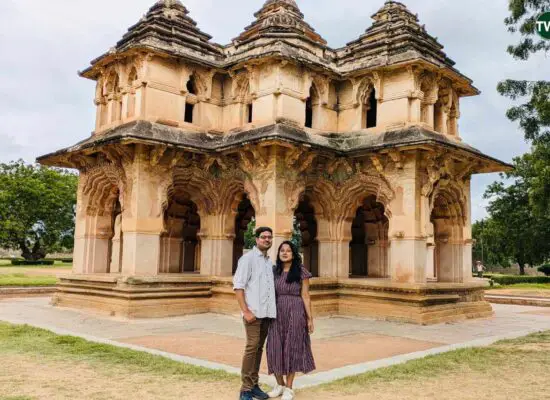Disclaimer: The author had visited Chittorgarh Fort with her family a few years ago. The article is a narrative of her personal experience. Also, this post contains a few affiliate links. If you click on them to make a purchase, we may earn a small commission at no extra cost to you. Read about our editorial policies.
A trip to Rajasthan remains incomplete without a visit to the historical fort of Chittorgarh. This majestic 7th-century fort is one of Asia’s largest and was declared a UNESCO World Heritage site in the year 2013.
Even after centuries, the valorous tales of Chittor’s Rajputs still fascinate us and serve as fodder for various literary and cinematic works.
Be it the Bollywood movie Padmaavat or books such as Raj Kahini, Padmavati: The Queen Tells Her Own Story, and Rani Padmini The Heroine Of Chittor.
Though most of these works are historical fiction, they give you a glimpse of Chittorgarh’s regal past.
Having thoroughly prepared myself before my visit to Chittorgarh Fort, I let our guide’s captivating narrative transport me to a bygone era in Chittorgarh’s history.
Now, let me take you through the epic history of the fort, how to reach this place, must-visit spots inside the fort and a complete guide to exploring the fort, also known as Chittaurgarh Fort.
Before that, if you’re planning a visit to Udaipur on the same trip, you can check out our complete guide to Udaipur.
Contents
A Quick Walk Through Chittorgarh’s History

For nearly 8 centuries, Chittorgarh stood as the capital of Mewar under the rule of the Sisodia Rajputs. It has been one of the few witnesses to the epic battles, triumphs and tragedies that unfolded on the country’s soil.
As per historical accounts, the construction of the Chittorgarh Fort is attributed to Chitrangada Mori, a ruler of the Mori Rajput dynasty. However, the fort was briefly seized by the Arabs and later reclaimed by the founder of the Mewar dynasty, Bappa Rawal, who is also celebrated for fighting off the Arab invasion of India.
Chittorgarh records 3 major historical events, when thousands of women performed Jauhar (self-immolation):
1. First was in 1303 A.D., when Alauddin Khilji invaded the fort and Rani Padmini along with 16,000 women sacrificed themselves.
2. In 1534 A.D., when Bahadur Shah defeated Chittor, Rani Karnavati (mother of Rana Udai Singh) performed Jauhar with 13,000 women.
3. In 1568, the wife of Maharana Pratap, Phool Kanwar Rathore performed Jauhar with 7,000 women during the reign of Akbar.
An annual fair known as the Jauhar Mela is celebrated every year to honor their sacrifice.
TWT Tip: We highly recommended that you hire a tour guide to know the intriguing sagas behind each of the monuments.
Looking for accommodations in Chittorgarh? Reserve your stay at one of the top-rated hotels!
15 Main Structures To Visit In Chittorgarh Fort
We began our journey into the Chittorgarh Fort from the Padal Pole (Padal Gate). This is the first of the 7 gates that you need to pass through to enter the fort.
Just outside the Padal Pole, you will find a Memorial built in honor of king Rawat Bagh Singh. An old board adjacent to it recounts the tale of how the ruler was martyred at this very location in 1534 A.D. while defending the fort against the army of Bahadur Shah of Gujarat.
Before reaching the final gate, we stopped briefly to view the Memorial of Sri Kallaji Rathore, who along with Jaimalji Rathore, met his martyrdom while defending the fort during the Mughal Emperor Akbar’s siege of Chittorgarh in 1568 A.D.
The final gate that we crossed is known as the Ram Pole and I was quite surprised to find people living inside the fort.
Did you know?
According to our guide, along with the Chittorgarh Fort, the Jaisalmer Fort is also a residence fort that serves as a home to about 500 families, who have been living there for ages.
Here are 15 main structures that we visited inside the Chittorgarh Fort:
1. Seven Gates of Chittorgarh Fort
As I mentioned earlier, you need to pass through 7 gates (pol) while exploring the entire fort. These gates are named Padan Pol, Hanuman Pol, Jodla Pol, Bhairon Pol, Ganesh Pol, Laxman Pol, and Ram Pol. Interestingly, your tour of the fort commences at the rear gate and concludes at the front gate.
2. Rana Kumbha Palace

The first monument that we encountered was Rana Kumbha Palace. Overlooking its boundary walls, you get the most mesmerizing panoramic vista of the Udaipur city, embraced by the majestic Aravalli Range.
The palace, despite enduring relentless assaults, remains a formidable and imposing edifice. It was severely destroyed by Alauddin Khilji who had captured the fort after defeating Rana Rawal Ratan Singh in 1303 A.D. And this is one of the most captivating tales of the Rajputana that I shall narrate shortly.
Later, the palace was restored by Rana Kumbha and is now named after him. According to our guide, the building was also the residence of Bappa Rawal and the birthplace of Maharana Udai Singh of Mewar, the visionary founder of Udaipur city.
Must Watch: Sound and Light Show
The Light & Sound Show at Kumbha Palace is a major attraction of the Chittorgarh Fort trip. It narrates a detailed history of the fort, pinpointing where each historical event unfolded. Sitting within the fort’s ancient walls and visualizing the historical narrative was truly a mesmerizing experience.
The show usually begins around 7.15 pm and you can enquire about it at the entry gate. The show is played once in Hindi and once in English every day and you can purchase your tickets as per your preferred language. When we visited the fort, the tickets had a nominal price of INR 150. You can also check out more details about the show and the fort on Rajasthan Tourism’s official website.

Now, rather than offering a mere overview of the palace’s various facets, allow me to immerse you in the fascinating tales that unfolded within these historic walls.
The Tragic Saga Of Rani Padmini:
During the 12th and 13th centuries, Mewar began facing numerous attacks from the Delhi Sultanate that consisted of Muslim-Turkic invaders. This was a time when Rana Rawal Ratan Singh ruled Chittorgarh and his queen Padmavati, or Padmini, was renowned for her celestial beauty.
According to the verses of the Sufi poet Malik Muhammad Jayasi, the fame of Rani Padmini’s beauty reached the ears of Alauddin Khilji of the Delhi Sultanate. Obsessed by the desire to possess her for himself, he ventured to Chittorgarh and expressed his desire to meet her.
In a bid to avoid warfare, Rana Rawal Ratan Singh agreed to allow Khilji to glimpse the reflection of the queen in a mirror. However, when he finally beheld her image, Khilji greedily approached the mirror seeking to touch the queen’s reflection. Repulsed by his conduct, Rani Padmini flung a stone and shattered the mirror into countless shards. (However, various historians and the locals dispute this narrative and assert that Khilji never laid eyes on Rani Padmini).
Soon after this incident, Khilji attacked the Chittorgarh fort and imprisoned the king. In a desperate attempt to save her husband, Padmini reached out to Alauddin Khilji, offering to surrender herself under the condition that he spare the King’s life. She also requested permission to bring her companions to Khilji’s palace. An ecstatic Alauddin Khilji eagerly agreed to all her terms.
However, what unfolded was one of the most ingeniously orchestrated operations in Rajput history. Rani Padmini concealed 800 palanquins with the kingdom’s finest warriors, each secretly armed but disguised as maidens. These palanquins were carried by 4 soldiers forming an army of around 3,200, who infiltrated the Khilji palace. As a fierce battle erupted, Rana Rawal Ratan Singh was safely escorted back to Chittor Fort.
Hence Khilji’s siege of Chittorgarh in 1303 held no surprises. The Rana’s forces were greatly outnumbered and knowing their inevitable fate, every woman within the fortress, led by Padmini, chose to commit ‘Jauhar’– a practice where Rajput women would jump into a pyre to safeguard their honor.
Within the Kumbha Palace, there is a hidden tunnel or cellar that leads to the sacred lake of Gau Mukh Kund. Legend has it that Queen Padmini committed Jauhar inside this cellar so that her ashes would merge into the lake and be forever beyond the reach of Khilji.
Wish to take a guided sightseeing tour of Chittorgarh? Book your activity now!
Maharana Udai Singh And The Sacrifice Of Panna Dai:
In 1535 AD, after the invasion of Chittorgarh by Bahadur Shah of Gujarat, Vikramaditya, the second son of Rana Sanga, managed to regain control of Chittor. However, being an ill-tempered ruler, he soon fell out of favor with the nobles and was imprisoned within the palace.
His younger brother Udai Singh was chosen to succeed him on the throne. Sensing an opportunity, Banvir, the illegitimate nephew of Rana Sanga assassinated the imprisoned Vikramaditya. He then set his sights on Udai Singh, next in line for the throne.
Fortunately, Panna Dai, Udai Singh’s loyal caretaker, concealed him in a fruit basket and sent him out of Chittorgarh with the help of another helper. In a daring move, she dressed her own son in the prince’s clothes and placed him in Udai Singh’s bed. When Banvir arrived, without hesitation she pointed to her son stating he was Udai Singh. Tragically, Banvir immediately slaughtered the innocent boy.
With all obstacles removed, Banvir ruled Chittorgarh for about 4 years till Udai Singh, who was living in Kumbhalgarh, marched to Chittor and reclaimed the throne in 1540.
3. Shwetambar Jain Temple / Sathis Deori Temple

Jain temples all over Rajasthan are true architectural masterpieces. I vividly recall delaying our entire travel team here as I exceeded the allotted time by more than 30 minutes. This group of temples within the Chittorgarh complex are steeped in history and adorned with some of the finest sculptures and massive domes. Among the collection of 27 temples, the Sathis Deori Temple stands as the largest. According to our tour guide, these temples trace their origins back to the 10th century and were constructed by a devotee named Karma Shah.
4. Kumbhaswamin Temple & Meera Bai Temple

The renowned Meera Bai Temple is situated within the Kumbhaswamin Temple complex and lies in close proximity to the Jain Temple. According to an inscription, the Kumbhaswamin temple was initially dedicated to Lord Varaha, an incarnation of Lord Vishnu. It was later renovated by Maharana Kumbha and was subsequently named after him.
I read somewhere that these temples exhibit Indo-Aryan architecture characterized by their pyramidal roofs and an array of pillars and walls that are adorned with fascinating ancient sculptures.
Our guide drew our attention to a sculpture that depicted Lord Vishnu resting on the Sesh Naag (Hindu snake god), with Brahma sitting on a lotus emerging out of Lord Vishnu’s navel. The sculpture bears a close resemblance to the idol of Lord Vishnu I had seen in the Padmanabhaswamy Temple in Kerala.
If you are not familiar with the legendary tale of Saint Mirabai, allow me to quickly break into a short story-telling session. Mirabai was a Rajput princess who got married to the crown prince of Chittor, Bhojraj Singh Sisodia. However, unfortunately, she lost her husband at a tender age during one of the wars with the Delhi Sultanate. Mirabai was an ardent devotee of Lord Krishna and her devotional songs continue to be celebrated even today. However, within a predominantly Shiva-worshipping Rajput community, Meera’s unwavering devotion drew disapproval.
According to tales narrated by my mother, and reiterated by our guide, there were numerous attempts to harm Mirabai. Though historical records may not confirm these tales, as a child, these greatly fascinated me. On one occasion, Mirabai apparently drank poison that was given by her brother-in-law. However, the poison miraculously changed into nectar and Meera remained unharmed. Another time a snake was placed in her room, only to transform into a garland. Eventually, Mirabai departed from Chittorgarh and traveled to Dwarka. After this, according to our guide, Chittor was bereft of all its joys.
5. Vijay Stambha (Victory Tower)

Our next destination was the magnificent Victory Tower. It is a soaring 9-storey masterpiece adorned with exquisite carvings that can captivate your gaze for hours. Our guide told us that in the past you could ascend up to the 8th floor and admire sculptures and idols from different religions decorating the tower’s walls.
The Vijay Stambh was built to commemorate the victory of Maharana Kumbha over two Mughal generals of Malwa and Gujarat. This 122 ft tall tower took about a decade to build and has an interesting alternating broad and narrow structure.
TWT Trivia:
On the 3rd floor of the Vijay Stambh (Victory Tower), an inscription in Arabic spells the word ‘Allah’. This significant detail seems to have played a pivotal role in preserving the tower during the Muslim invasions of Chittorgarh.
6. Chittorgarh Fort Garden
Chittorgarh Fort has some beautiful gardens where you can rest or simply stroll around. However, according to our guide, a certain part of the garden within the boundary wall, marked as Jauhar Sthal, was previously a pit that was used for performing Jauhar.
7. Samadhiswara Temple

This exquisite temple dating back a thousand years was commissioned by Raja Bhoj, only to be destroyed by Alaudddin Khilji. In 1428, it underwent a remarkable renovation during the rule of Rana Mokkal. Apart from the temple’s architectural beauty, the union of Hindu gods Lord Shiva, Lord Vishnu and Lord Brahma in one idol carved out of a single stone is sure to leave you fascinated.
8. Gaumukh Lake

The Gaumukh reservoir, also known as the Gaumukh Ganga, is a sacred lake nestled within the Chittorgarh Fort. Its water flows from a spring and emerges through a structure shaped like a cow’s head. However, the true source of the water still remains a mystery.
Tradition holds that the queens of the fort would travel through the tunnel in Rana Kumbha Palace, bathe in the lake’s water, offer worship to the Shiva Linga located beneath the cow’s head and return to the palace.
According to our guide, one has to climb down 84 steps, which are at present submerged in water, to reach the lake. You can also get an amazing view of the city from Gaumukh Lake.
9. Kalika Temple

An interesting fact that I got to know from our guide was that this temple was previously dedicated to the Sun God. It was supposedly the second Sun Temple after the Konark Sun Temple. All the Rajput kings used to pay homage at this temple before going to war and it is believed that the power of the sun guided them to victory. In 1313 A.D., Amer Singh installed an idol of Goddess Kali and since then it has been referred to as the Kalika Mata Temple.
TWT Tip: Numerous monkeys roam the temple premises that are known to snatch tourist’s belongings. You might want to securely store your cameras and other essentials in your bag. Try carrying some animal-friendly snacks with you to feed them.
10. Padmini’s Palace

I was told by our guide that Padmini’s Palace, which is located amidst a water body, was also called the Jal Mahal (Water Palace). It was reserved for entertaining esteemed guests who visited the palace.
It is here that the story of Alauddin Khilji catching a glimpse of Rani Padmini occurred, ultimately leading to the historic Battle of Chittorgarh in 1303 A.D.
Interestingly, Padmini’s Palace was one of the earliest island palaces that were built by the Rajputs, a trend that soon became popular and can be viewed in the masterpieces — the Udaipur Lake Palace and the Jal Mahal in Jaipur.
11. Adbhutanath Ji Temple
As I have told you before, the fort was built by Chitrangada Mori who belonged to the Mori or local Maurya dynasty. Hence, you can still find many structures within the fort that are built in the Mauryan style. The Adbhutanath Shiv Ji Temple exemplifies this influence.
If you carefully examine the sculptures on the outer walls of the temple, you will find dragons at the corners, which is not typical of Hindu temples that often depict scenes from Hindu mythology. Surprisingly, the idol in Adbhutanath Ji Temple looked quite similar to the idol we had seen in Samadhishwara Temple. The faces of Brahma, Shiva and Vishnu are carved out of a single stone resembling the union of the Creator, Destroyer and Protector.
12. Kirti Stambha (Tower Of Fame)

Near the Kirti Stambha, an inscription caught my attention, revealing that the tower was erected in the 12 century by the Digambara Jain Community. This colossal 7-storey, 75-foot-high tower is dedicated to Adinatha Rishabhdev, who was the first of the 24 Tirthankaras (spiritual teachers) in Jainism. While ascending the tower is prohibited, our guide informed us that it only displays sculptures of Digambaras on its outer walls with plain interiors.
13. Ratan Singh Palace

This beautiful palace, built by Rana Ratan Singh II, once served as the winter abode for the royal families. With its massive gates, imposing tombs, sculpted walls and pillars, it is evident that the palace once held great significance in Rajput history.
It overlooks the beautiful Ratneshwar Pond, which according to our guide, never dries up. On the northern side, you will find a temple dedicated to Lord Shiva, named Ratneshwar Mahadev Temple, after Rana Ratan Singh II. The palace is also renowned for its expansive courtyards and beautifully landscaped gardens.
TWT Trivia: There are 22 ponds/tanks within the Chittorgarh Fort that don’t dry up throughout the year. The fort once had 84 water bodies, 8 palaces, and 113 temples before many of them were razed by Akbar’s army.
14. Fateh Prakash Palace

The Fateh Prakash Palace, formerly Rana Fateh Singh’s residence, is a distinct departure from the architectural style you observe in Rana Kumbha’s Palace and Ratan Singh’s Palace. This palace had a contemporary charm that reminded me of the palaces in Udaipur.
After independence, a portion of the palace was converted into a museum, resulting in meticulous upkeep of the entire structure. From what I recall, the museum requires a separate ticket and is not included in the general ticket purchased while entering the fort.
After exploring the Chittor Fort mainly on foot, the shade of the museum in the scorching weather was quite refreshing. To our relief, the museum also offered amenities like washrooms and cold drinking water.
The museum is well-maintained and showcases a diverse collection of weaponry, armor, vessels and portraits. It also provides valuable insights into intriguing historical events and offers information about each of the fort’s significant monuments. Moreover, visitors can also marvel at the miniature model of the entire fort that is on display within the museum.

What Are The Tourist Destinations Near Chittorgarh Fort?
We only visited Chittorgarh Fort and our itinerary did not include the tourist destinations near the fort (the downside of visiting with a tourism organization). However, if you have an extra day to spend in Chittorgarh, here are some places you can visit:
- Shri Sanwaliya Seth Prakatya Mandir Bagund (Temple)

Located in Bhadsora, about 40 km from Chittorgarh Fort, this beautiful temple is a must-visit for all traveling to Chittorgarh. Dedicated to Lord Krishna, the temple is visited by thousands of devotees every year.
The temple complex is massive and has beautiful landscaped gardens. Apart from its intricately carved exteriors, the main hall where the deity resides is adorned with silver, gold and glass inlay work that may remind you of Sheesh Mahal in Udaipur City Palace.
Location: Village Mandafiya, Dist, Bhadsora, Rajasthan – 312024
Timings: 5 am-12 pm, 2 pm-11 pm
- Mahanal Mandir and Math
If you take an interest in ancient ruins, the Mahanal Mandir and Math are sure to captivate the history lover in you. Located about 89 km from Chittorgarh Fort, this temple is dedicated to Lord Shiva. The pillars have intricate carvings of deities and apsaras. A massive stone sculpture of Nandi (Hinduism’s bull god) facing the deity greets you at the entrance. The scenic beauty of the place is mesmerizing and the Menal waterfall near the temple adds to the magic.
Location: Menal, Rajasthan – 312023
Timings: No specific timings
There are also two wildlife sanctuaries nearby — Bassi Wildlife Sanctuary and the Sitamata Wildlife Sanctuary. Amongst these, the latter offers a good opportunity for trekking in the wilderness.
How Can You Reach Chittorgarh Fort?
Chittorgarh Fort takes 2 hours and 15 minutes to reach from Udaipur (distance of 118 km). The Chittaurgarh Junction is the nearest (6 km) railway station to the Chittorgarh Fort and there are regular trains available from Udaipur, Jaipur, Delhi, Ahmedabad, and Bhopal. The nearest airport is Maharana Pratap Airport, located in Dabok.
Frequently Asked Questions On Chittorgarh Fort
1. What are the timings of Chittorgarh Fort?
The Chittorgarh Fort is open from 9 am-5 pm everyday.
2. What is the entry fee for Chittorgarh Fort?
The entry fees for Chittorgarh Fort are INR 150 for Indians and INR 200 for foreign nationals.
3. Should I book Chittorgarh Fort tickets in advance?
There is no need to book Chittorgarh Fort tickets in advance. The tickets can be easily bought at the entrance of the fort. You can book your tour guide here as well.
4. What is the ideal way to explore Chittorgarh Fort?
The best way to see Chittorgarh Fort is either on a rented two-wheeler or an auto, and the rest on foot. Both two-wheelers and autos are affordable and easily available.
5. What are the accommodation options near Chittorgarh Fort?
Some of the best-rated hotels near Chittorgarh Fort include:
- Hotel Kumbha Retreat Spa – A 3-star hotel with a rooftop cafe located just 15 minutes from the Chittorgarh Fort.
- Rajasi Resort Chittorgarh – A nominally priced Haveli-styled resort located at Semalpura, about 30 minutes from the fort.
- Hotel Royal Palace – A Haveli-style 3-star hotel located just 17 minutes from the fort, recommended for its beautiful, spacious rooms and great service.
- Castle Narela Lake Resort – A beautiful Haveli-styled resort, located about 46 minutes from the fort, and popular for its sprawling courtyard, spacious rooms and royal vibe.
- Kudka Resort – A modern hotel located 18 minutes from the fort that offers good food and cozy rooms.
- Hotel Pratap Palace – A beautiful ancient heritage property located 18 minutes from the fort with spacious rooms, antique decors and an in-house restaurant.
6. Which are the best restaurants near Chittorgarh Fort?
Some of the best restaurants near Chittorgarh Fort where you can try some authentic Rajasthani dishes are Rajasthani Gangour Restaurant near Padan Pole, Rajasthan Restaurant near LIC Office, and The Victory Restaurant near Vijay Stambh. You can even head off to Mithai Bazaar for some mouth-watering desserts.
7. What are the local culinary specialities to try in Chittorgarh?
Chittorgarh is famous for Rabdi Ka Malpua, Dal Bati Churma, Gatte Ki Sabji, Mawa Kachori, Poha, and Rajasthani Thali.
8. Is Chittorgarh Fort haunted?
Rajasthan, despite its glorious history, has witnessed some of the most fierce battles and tragic mass suicides. This is why there are a number of places that are known to be haunted and visits are prohibited at night. One such place is the Rana Kumbha Mahal in Chittorgarh Fort. Owing to the three major Jauhar incidents that unfolded in this fort, many tourists have reported hearing the sounds of bangles, anklets or frightful screams of helpless women. Some tourists have also claimed to see a woman asking for help and if you turn around to see her, you’ll notice her face is half burnt. However, there is no way to validate these claims. Also, all these sightings have occurred in the evening and the fort is no longer open to tourists after 5 pm.
TWT Summary
Chittorgarh fort holds great historical significance for anyone who is visiting Rajasthan. While Udaipur and Jaipur give you a sneak peek into the opulent lifestyles of the maharajas, Chittorgarh Fort offers a unique perspective. It was not just a glimpse of royalty, but the living evidence of the pain and sacrifices endured by generations of Rajputs to safeguard their royal legacy.
Walking through the very spaces that witnessed tragic battles, Jauhars and also celebrated acts of valor, evoked immense pride that was laced with a deep sense of sadness. Our journey to Chittorgarh was nothing short of a lifetime experience and definitely a trip that every traveler should make once in their life.
Built By: Chitrangada Mori
Chittorgarh Fort Area: 692 acres
Visiting Time: 9 am-5 pm
Ticket: INR 50 for Indian adults, INR 25 for Indian kids & INR 200 for foreigners
Tour Guide Charges: Around INR 500
Location: https://maps.app.goo.gl/rabuNdggLF1x56eQ8

Love Traveling? We’Ve A Lot More Helpful Guides For You! :






2 thoughts on “Chittorgarh Fort: A Witness To Rajasthan’s Epic, Glorious History”
Very well written with detailed information. Will be very handy for travelers who loves to visit historical places.
Thank you very much for taking the time to leave your valuable feedback on our content. 🙂